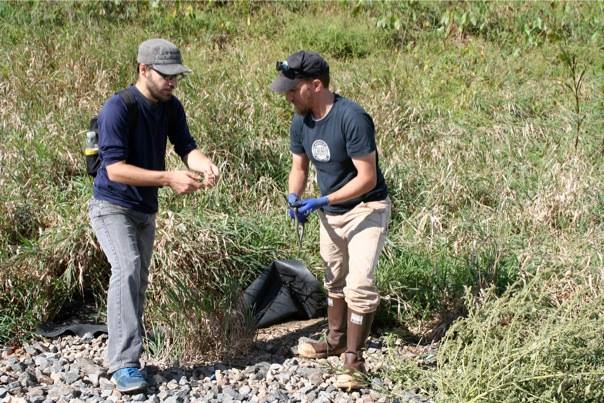Tristan Schramer is a fellow field herper who, when not attending college, volunteers his time with Fermilab's ecology program under head ecologist Ryan Campbell. Tristan is well-trained in ecology but like me, his primary interest is herpetology. A project he has been heavily involved in is surveying the entire accessible portion of the site for reptiles and amphibians. He collects data on distribution patterns of various species and is hopeful that his efforts can prove the existence of one or several uncommon species. As Fermilab provides a lot of habitat (or potential habitat) for native species, it is important to understand what species are present, where they occur, and how past developments have impacted their existence on the site. The more data Tristan has, the more prepared Ryan is in writing up land management plans and conducting restoration practices such as prescribed burns. With the exception of a few small and isolated preserves, the vast majority of the land surrounding Fermilab has been developed into housing subdivisions, malls, industrial parks, an airport, and golf courses. Tristan would like to see Fermilab remain a safe haven for herps and actually help improve the site with the help of other volunteers and of course, Ryan.
Tristan & crew organized a herp blitz that took place on September 19th and he was kind enough to invite me to help out. It was be a day-long affair - we'd meet in the morning, go over the plans, break into groups, and head out in search of herps. It ended up being a true "dream team" of very knowledgeable, respected, and experienced field herpers, the likes of which I like to work with since I can pull from those people to improve my own methods. Tom Anton, Tristan and Ryan, Matt Bordeaux and his wife Shannon (and their young daughter, a pro field herper in the making), Matt Ignoffo and his two kids, Doug Mills, Yatin Kalki, Sam Brolley, and Stephen Spanos, as well as others who remained at the "home base" office throughout the day.
My group (Ryan, Doug, sometimes Sam, and myself) explored the site by truck. We used a map and GPS coordinates to locate cover board arrays throughout the north portion of the site.
Here's Doug with a great find, a Western fox snake (Pantherophis vulpina) we found under a cover board in a wetland.
A plant that distracted us for a few minutes - nodding ladies' tresses (Spiranthus cernua), a not-super-common species that is an indicator of a healthy ecosystem.
This active railroad embankment is the eastern border of Fermilab. Just east of here are a few parks and subdivisions. Immediately to the west (right of the tracks in this photo) is where a thick stand of buckthorn (Rhamnus cathartica) had just been removed (note the bare ground). West of that is a thin strip of true remnant prairie, itself bordered by hundreds of acres of soybeans and a buzzing powerline.
Not surprisingly, the tracks gave up a good amount of herps, mostly garter snakes of two species (Thamnophis sirtalis and T. radix). Here, I explain to Ryan the difference between a male and a female (photo by Doug Mills).
Toward the end of the day, all the groups coalesced and searched for smooth green snakes (Opheodrys vernalis) in an area where one was found last year. No smooth greens were found, but a whole bunch of garters and brown snakes (Storeria dekayi) were. This particular cover board produced a bunch of young brown snakes (photo by Tristan Schramer).
Here we are, heading to an old gravel lot where disused equipment rots and disintegrates.
One of our last finds of the day was a chunky tiger salamander (Ambystoma tigrinum) I found under a piece of junk behind some abandoned truck trailers. It, along with every other find, was photographed as a voucher specimen and submitted to HerpMapper.
The team!
At the end of the day, we collected enough data to sort over for weeks. We all had a ton of fun, and I learned a lot from my blitz mates. Here's to Fermilab and its herp diversity - and hopefully, there is a lot more to discover for next year.








No comments:
Post a Comment